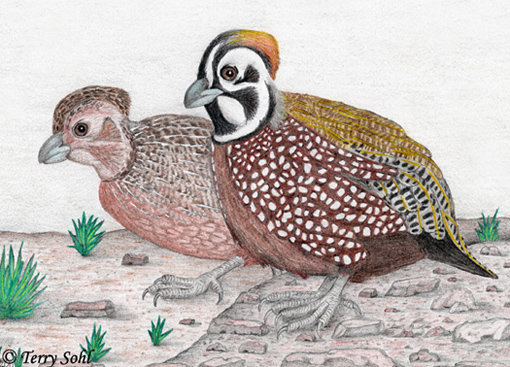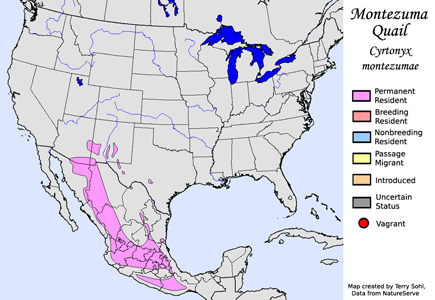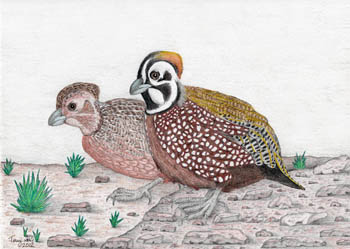| Length: 8.5 inches | Wingspan: 14.5 inches | Seasonality: Non-resident in South Dakota |
| ID Keys: Intricate, harlequin-like facial pattern, white dots on blackish-brown sides (male), bluish-gray bill | ||
 Montezuma
Quail are intricately patterned quail of Mexico and the southwestern U.S.
Sometimes referred to as the "Harlequin Quail" for the males bold facial
pattern, they are nonetheless difficult to observe in their normal grassy
habitat. When danger is sensed, they typically remain motionless, only
exploding into flight when a threat comes very close. They typically
require tall grass areas for feeding, and are negatively affected by
livestock grazing. Sharp local declines have been noted in grazed
areas of their range, including throughout Mexico. Nonetheless, they
are still considered a gamebird species throughout much of their range.
Montezuma
Quail are intricately patterned quail of Mexico and the southwestern U.S.
Sometimes referred to as the "Harlequin Quail" for the males bold facial
pattern, they are nonetheless difficult to observe in their normal grassy
habitat. When danger is sensed, they typically remain motionless, only
exploding into flight when a threat comes very close. They typically
require tall grass areas for feeding, and are negatively affected by
livestock grazing. Sharp local declines have been noted in grazed
areas of their range, including throughout Mexico. Nonetheless, they
are still considered a gamebird species throughout much of their range.
Habitat: They are most often found in areas of tall grass with scattered trees, such oak savannahs. In higher elevations, then can sometimes be found in openings in conifer forests.
Diet: Bulbs and tubers of certain plains make up a large part of the diet in some seasons. They will also eat acorns, nuts, seeds. Insects are also an important part of the diet in most seasons.
Behavior: Does much of its feeding by scratching and digging on the ground for bulbs and tubers. They will also scratch through vegetation litter in search of insects. Most foraging is done as a covey, or by a mated pair. Covey size is smaller than many quail species, often fewer than 10 birds in fall and winter.
Nesting: Montezuma Quail nest on the ground, building a nest of grasses in a shallow depression, typically in an area of tall grass. Female probably does most of the incubating, but both parents will help to raise young.
Song: The male sings a descendeing, haunting whistle, as well as making a series of other calls. When individual birds in a covey are separated, a series of low whistling notes are used to resassemble the covey.
Migration: Considered a permanent resident throughout its range.
Interactive eBird Map: Click here to access an interactive eBird map of Montezuma's Quail sightings
Similar Species: Distinctive facial pattern if seen well. Overally most similar quail is the Northern Bobwhite.
Conservation Status: Populations of Montezuma Quail have been negatively impacted by habitat loss. Heavy livestock grazing has a strong negative impact on the species. They are listed as a "watch species" nationally by Partners in Flight.
Further Information: 1) Cornell's All About Birds - Montezuma Quail
2) USGS Bird InfoCenter - Montezuma Quail
3) New Mexico Partners in Flight - Montezuma Quail
Image Information: Colored pencil drawing by Terry Sohl - January 2012
| Click below for a higher-resolution map |
 |
| South Dakota Status: Non-resident in South Dakota |
Additional Montezuma Quail Images

